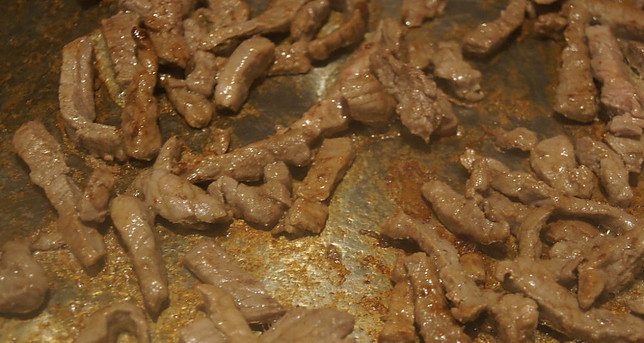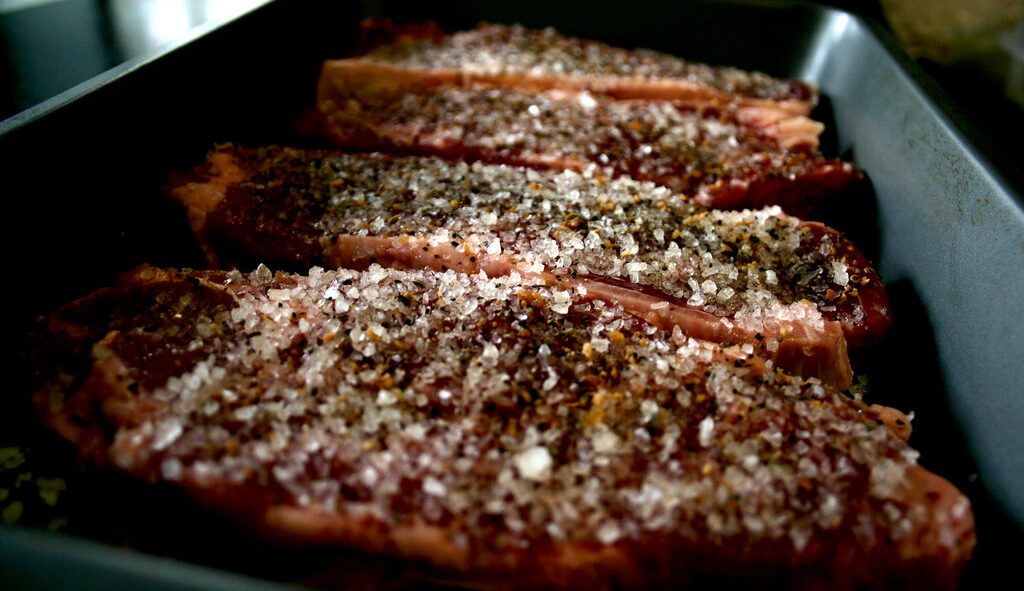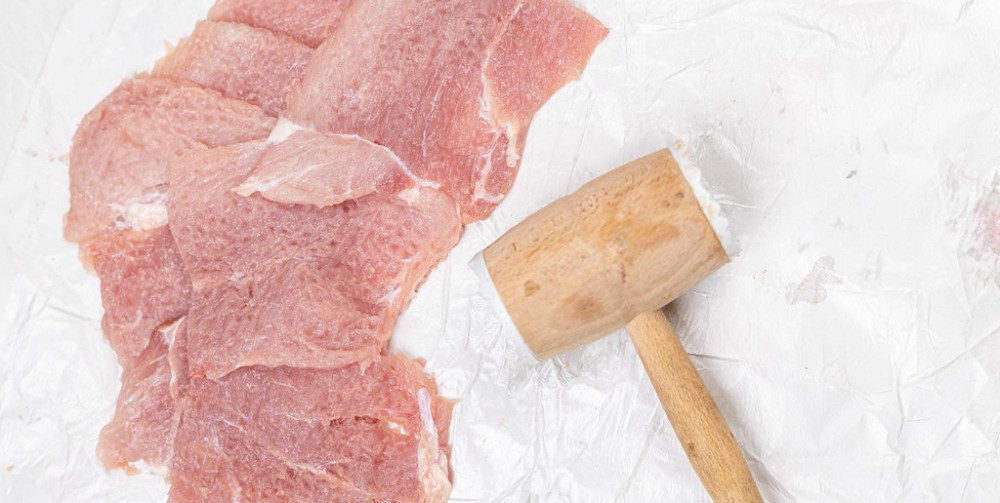Why Is My Minced Beef Tough
Do you like stir fry, but whenever you make it with beef (or any kind of meat for that matter), the strips always seem to be tough and hard to chew?
Are you asking, " Why is my stir fry beef always tough?"
I, too, have had this problem and wanted to find out why. I found many possibilities and have narrowed them down to three main reasons.
Let's find out what they are.
Why Is My Stir Fry Beef Always Tough?
There are three primary reasons that your stir fry beef will be tough. If you are using a lean and less tender cut of steak, like sirloin tip, flank, or skirt steak, and you didn't tenderize it, the meat will more than likely be tough. In addition, you may not be cutting the meat correctly or making your beef strips thin enough. A third factor is you are cooking your beef too long over medium or low heat.
1. You Didn't Tenderize Your Meat

If you have a cut of steak that is naturally tough, I recommend you tenderize it,
Steak such as:
- skirt
- flank
- sirloin tip
- chuck
- round
- top sirloin
- any steak with little marbling
- low-quality or budget steak
Two Reasons for Toughness
Steak is tough because of the connective tissue, lack of marbling, and more muscle fibers in the meat or because the steak lost too much moisture in the cooking process.
Steak loses too much moisture by overcooking or cutting into your steak before it has had a chance to rest.
Tenderizing will help with the first reason, but not so much the second.
So, remember to let your steak rest.
Yes, even beef strips can benefit from resting for a few minutes while cooking the vegetables.
But, if your steak is one of the cuts mentioned above, then using a tenderizing method will also help break down the fibers.
6 Ways to Tenderize
Marinating
This method is ideal for thinner cuts such as flank, skirt, and sirloin tip or steaks that have been mechanically tenderized.
That's because marinade on its own doesn't penetrate very deeply into the meat.
Neither does marinade itself tenderize. It all depends on what you put in it.
Salty liquids such as soy sauce are good. Soy sauce not only flavors the meat, but the salt will also help tenderize.
Acidic citrus juices are another popular ingredient for a marinade. The acid helps break apart the fibers, and the citrus adds flavor. Another acidic liquid that works well is apple cider vinegar.
But if you use an acidic liquid, you won't want to marinate for more than 8 hours, and probably not longer than 4 or 5 hours because the acid can make the surface or your beef mushy and might even be a reason for your steak being tough.
When marinating your steak, sometimes combining this method with another method, such as pounding or scoring, will increase the chances of having tender steak.
Salting

Adding salt to your meat is a must regardless of whether you use another method or not.
Salting may not work with beef strips unless you salt the steak before cutting it into strips.
And, if you marinate using salt or a salty liquid, you won't need to use this method at all.
But salting works well with pounding or scoring.
So, to use this method, salt both sides of your steak and let it sit for 40-60 minutes.
Use a coarse kosher or sea salt if you have it. But table salt will also work.
The salt draws out the moisture from the meat and mixes with the salt to create a salty brine on the surface. As it sits, the brine reabsorbs into the beef to break down the muscle fibers.
If you don't have the time to let your steak sit for at least 40 minutes, it's better not to use this method. If the salty brine doesn't have time to reabsorb and work its magic, all you will do is draw out the moisture.
And the opposite will happen. Rather than tenderizing, you will be making your meat tougher.
Mechanical Tools
Affiliate Disclosure: I am a participant in the Amazon Services LLC Associates Program. If you make a purchase using an affiliate link, I receive a small commission.
If you want to tenderize your beef physically, you can use two basic tools: a meat hammer or a meat tenderizing tool with tiny needles that poke into your meat.
You use either of these tools on your steak before you cut it into strips.
The meat hammer is what I've referred to as pounding. It has two surfaces, a flat and a textured side. For tenderizing, you will use the textured side.
As you pound your steak, the textured side will break up the muscle fibers, causing your meat to be more tender.

I use the Kitchenaid Gourmet Meat Tenderizer.
A meat tenderizing tool has needles that work in the same way. The tiny needles poke holes in the meat and break up the fibers. Having little holes in your steak also makes it ideal for marinating, velveting, and even salting.
The only issue I see with using a mechanical tool is knowing when to stop. It is possible to overdo it and end up with a mushy or flabby steak.
And, of course, when making beef strips for stir fry, you will want to cut the meat after you have pounded or poked it.
Scoring
The scoring method involves using a knife to make shallow cuts diagonally across the top of your steak, usually in both directions. And on both sides.
Scoring does the same thing as pounding or poking does. If you combine any of these methods, you run the risk of overdoing it.
Scoring, pounding, or poking all work very well (and are even encouraged) with marinating, velveting, salting, or powders.
Powders
There are many products for tenderizing meat that come in powdered form.
If you like quick and easy, a tenderizer in powder form may be just what you need.
Often, after sprinkling some tenderizer on your meat, you will add it to a marinade, but I don't think you have to.
And, to be safe, I recommend following the instructions on whatever tenderizing powder you have.
If you would like to know more about using a tenderizing powder, check out my review on Adolph's Unseasoned Tenderizer.
Velveting
Velveting is a method similar to marinating and is a common practice in Chinese cooking.
Mix together an egg white, cornstarch, salt, and rice wine or honey. Add your beef strips, cover, and refrigerate for 30 minutes.
Now it's time to cook the beef strips. There are two ways to do this; in water or oil. In Chinese restaurants, they use oil, but the water method works fine for home cooking.
If you want to use oil, it's best to cook the strips in batches so as not to crowd the pan or end up cooking them too long.
Since you are cooking over high heat, use an oil with a high smoke point, such as avocado, vegetable, or canola.
Heat enough oil to cover the surface of the pan. Now add a single layer of beef strips, and cook each side for about 10 seconds.
Remove the first batch and add another until you have cooked all your beef. You may have to put in more oil if needed.
Now for the water method.
Fill your pot or pan with water and add about a teaspoon of oil. Bring it to a boil and add the meat. Cook 40-60 seconds depending on the thickness of your strips, then remove.
Watch the video below to see how it's done.
How To Velvet Meat – Velveting Meat Chinese Tutorial
2. You Don't Know How to Cut Your Steak Correctly
The whole thing about tough meat is the many muscle fibers and connective tissue within your steak.
So, when you cut across the grain, you break up the fibers to get a more tender cut of meat.
Why does this work?
Because the muscle fibers are now shorter and easier to chew.
You want to cut against the grain when making your beef strips, whether you cut it raw or after it's cooked.
Some people recommend cooking your steak whole, then cutting it into strips so that your steak is more tender, and easier to cook to the doneness you want.
They say the strips will finish cooking when you add them to the vegetables.
When marinating or velveting, though, it seems like most people cut their meat first, which is how I do it.
Meat Answers, in How To Cut Steak Against the Grain , tells you even more about its importance.
3. You Didn't Cook the Beef Quickly Over High Heat
You want to cook your beef quickly over high heat so you don't overcook it.
Beef strips do not take long to cook, so it will be easy to leave them in too long.
Once you cook all the moisture out, you are left with dry meat that is tough and chewy.
Cooking can take as little as 1 minute on each side or a little longer if you cut your strips are thicker.
But the thinner, the better.
Always cook your beef first and set it aside while you cook your vegetables. The meat will be resting.
Making Beef Stir Fry in Cast Iron
Cast iron is a good choice for making stir fry because it retains its heat so well.
A successful stir fry is crisp, not mushy. And cast iron is great for making crispy.
You may think you need a wok if you want to make stir fry, and they do make cast iron woks, but if all you have is a cast iron skillet, you are good to go.
Can You Stir Fry in a Cast Iron Skillet? Of Course, You Can
Final Thoughts
So, if you are asking, "Why is my stir fry beef always tough?" you now have at least three factors to consider.
Cuts of steak with more muscle fibers and connective tissue will be tougher but generally more budget-friendly. And as long as you know how to do a few things, you can make any steak tender.
Tenderizing your meat is probably the best way to keep your steak from being tough.
But cutting against the grain and cooking your meat fast over high heat are two other ways to help your beef be tender.
One last thought: When making stir fry, the preparation of the food will take the longest. Cut all your vegetables and tenderize your beef before you start cooking. The actual cooking will take less than 10 minutes.
If you know some other ways to keep stir fry beef strips from being tough, you can share them in the comment section below.
Source: https://trycookingwithcastiron.com/why-is-my-stir-fry-beef-always-tough-3-factors-to-consider/
0 Response to "Why Is My Minced Beef Tough"
Post a Comment